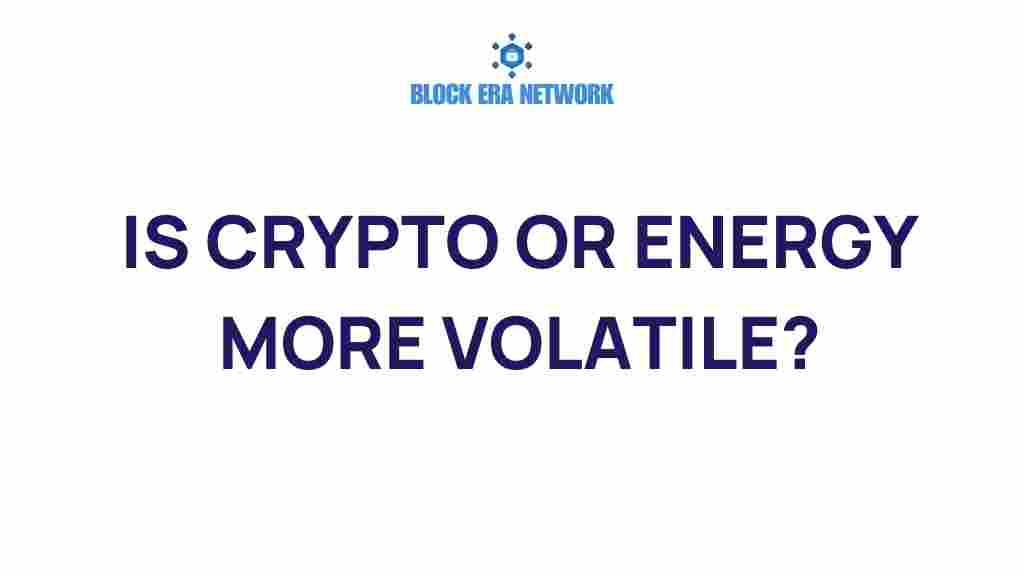The world of investing often hinges on one critical factor: *volatility*. For traders and investors, understanding where volatility stems from is crucial for making informed decisions. Two markets known for their sharp fluctuations are **cryptocurrencies** and the **energy sector**. But which of these holds the title of the ultimate volatility king? Let’s dive in to compare the *crypto volatility* phenomenon with the dynamic swings of the energy market.
Understanding Crypto Volatility
Cryptocurrency markets are notorious for their erratic price movements. One day, Bitcoin could be soaring to record highs, and the next, it might plummet by double digits. This *crypto volatility* stems from several factors:
- Speculation-Driven Market: Cryptocurrencies often attract speculative traders who respond quickly to market news, driving prices up or down.
- Lack of Regulation: Unlike traditional financial markets, the crypto sector operates with minimal oversight, creating room for manipulation and rapid shifts.
- Emerging Technology: Blockchain and cryptocurrency technologies are still evolving, leading to uncertainty and dramatic price swings.
For instance, Bitcoin experienced a massive crash in 2021, dropping by over 50% within a few weeks. Such wild changes often leave investors both thrilled and terrified, showcasing the unpredictable nature of crypto markets.
Energy Market Volatility
The energy sector, especially oil and gas, has historically been prone to substantial price changes. Key contributors to energy market volatility include:
- Geopolitical Events: Conflicts, trade sanctions, or decisions by major oil-producing nations can cause abrupt price swings.
- Supply and Demand Imbalances: Seasonal demand variations or unexpected disruptions, such as hurricanes, directly impact energy prices.
- Technological Advancements: The rise of renewable energy and efficiency improvements can alter demand for traditional fuels.
For example, during the COVID-19 pandemic, oil prices famously turned negative in April 2020 due to a collapse in demand and lack of storage. This highlighted the extreme sensitivity of the energy sector to external shocks.
Comparing Crypto and Energy Volatility
When juxtaposing these two markets, their volatility profiles reveal stark contrasts:
- Crypto: Changes occur within seconds, driven by social media trends, regulatory announcements, and market sentiment.
- Energy: Price shifts tend to unfold over days or weeks, influenced by macroeconomic trends and policy changes.
Although both markets are volatile, the frequency and magnitude of *crypto volatility* often outpace the swings seen in energy prices. However, energy’s impact on global economies is far-reaching, making its volatility equally significant.
How Investors Can Navigate Volatility
Whether you’re dabbling in crypto or energy stocks, managing risk is crucial. Here’s how you can safeguard your investments:
Step-by-Step Guide for Mitigating Risks
- Understand Market Trends: Regularly monitor market trends and news. For crypto, follow blockchain developments, while for energy, track geopolitical news and inventory reports.
- Diversify Investments: Don’t put all your eggs in one basket. Spread your investments across different sectors to reduce risk.
- Set Stop-Loss Orders: Use stop-loss mechanisms to limit potential losses in both crypto and energy trading.
- Stay Educated: For crypto, learn about new tokens and platforms. For energy, study oil and gas production trends and renewable energy shifts.
Troubleshooting Common Issues
Despite precautions, traders often face hurdles in these volatile markets. Here’s how to address some common problems:
- Sudden Price Drops: Maintain a long-term perspective and avoid panic selling.
- Overexposure to a Single Asset: Regularly review and rebalance your portfolio.
- Emotional Trading: Rely on data-driven decisions instead of reacting impulsively to price changes.
The Bigger Picture: Crypto Volatility vs. Energy Volatility
While cryptocurrencies dominate the headlines with their wild fluctuations, the energy market plays a foundational role in global economics. Each sector’s volatility brings unique opportunities and challenges:
- Crypto: High-risk, high-reward. Ideal for speculative traders and those seeking rapid gains.
- Energy: Slower, systemic changes. Often tied to long-term strategies and macroeconomic shifts.
Ultimately, the choice between investing in crypto or energy depends on your risk tolerance, investment goals, and market expertise.
Conclusion
Whether crypto or energy markets hold the true title of volatility king depends largely on your perspective. *Crypto volatility* is undeniably more dramatic, drawing in thrill-seekers and speculative traders. Meanwhile, energy market fluctuations carry profound implications for economies worldwide.
To thrive in either market, it’s crucial to stay informed, remain disciplined, and adopt a robust risk management strategy. Ready to dive deeper? Explore more insights on market dynamics by visiting our comprehensive resource hub.
This article is in the category and created by Block Era Network Team
